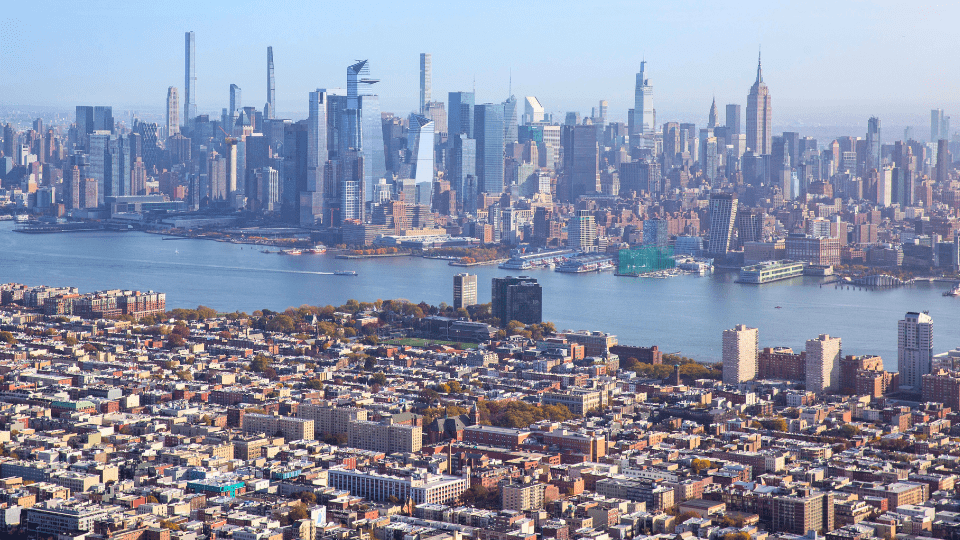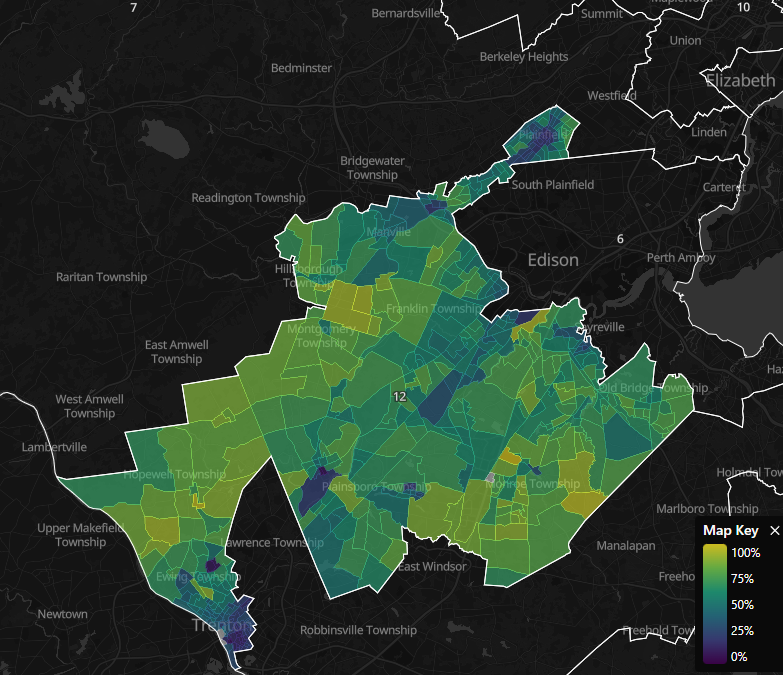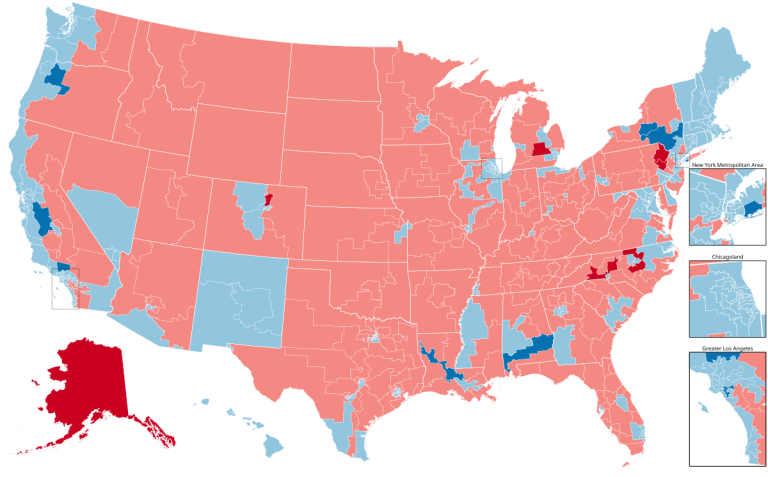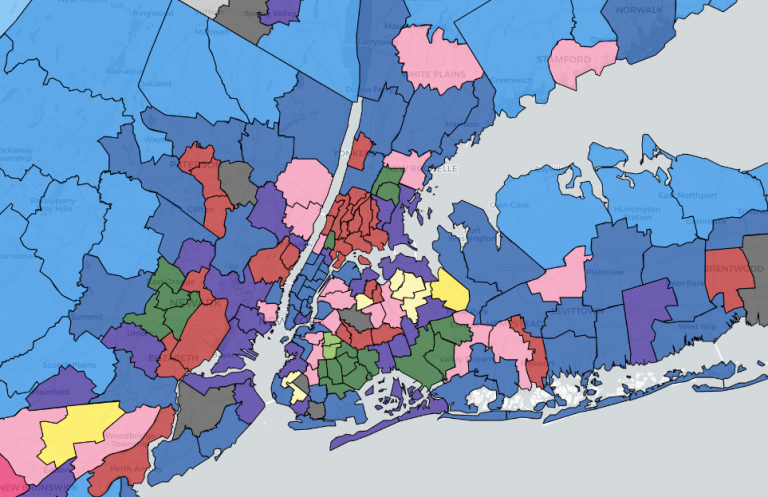
The 2025 elections are over, but primary election season for the 2026 midterm elections is entering full swing. In both New York and New Jersey, we are about seven months away from statewide primaries, where we will see several competitive races. Will purported outsider candidates from the “Democratic Tea Party” show up? Are we going to see incumbents ousted? Well, by looking at the demographics of certain districts, maybe we can get a clue as to what will happen.
On November 10, NJ-12 incumbent Watson Coleman announced she would not be running for re-election. Meanwhile, former mayoral candidate and NYC Comptroller Brad Lander stated he is seriously considering running in NY-10. We took a deep dive into these districts to get an idea of what type of voters live there and what kinds of candidates we can expect.
New Jersey’s 12th Congressional District (NJ-12)

NJ-12 stretches throughout the central part of the state, mostly consisting of suburban areas of New York City and the capital, Trenton.
Results in NJ-12
Democrats have won every major election here in the Trump era, but like a lot of areas in the state, it shifted toward Trump from 2020-2024. Jack Ciattarelli, the Republican nominee for Governor in 2021 and 2025, fared well here in 2021 compared to Trump in 2020, but took a big step back in 2025. It’s possible that Sherrill’s victory margin, which was better than Clinton’s in 2016, portends a rebound for Democrats among minority voters. Or it’s just a low-turnout artifact. We shall see!
2016 President: D+31.4
2020 President: D+34.3
2024 President: D+23.8
2021 Governor: D+23.1
2025 Governor (Estimate): D+32.3

Turnout in NJ-12
Turnout here has been varied, but it’s generally been average compared to the 100K District National Average. Turnout is much higher in the suburban and exurban areas than in urban areas, mainly Trenton and Plainfield.
2016 President: 50.9% (49.7% National Average)
2020 President: 58.6% (60.0%)
2024 President: 56.2% (58.8%)
2021 Governor: 33.6%
2025 Governor (Estimate): 40.2%

Ethnicity & Ancestry in NJ-12
NJ-12 is a diverse district, with every major ethnicity comprising at least 15% of the district. The urban areas in Plainfield and Trenton are mostly Black and Hispanic, which leads us back to turnout rates. Generally, Black and especially Hispanic areas tend to have lower turnout than average, while White areas tend to have higher turnout. Asian areas, consisting mostly of South Asians, are concentrated in the central and southern parts of the district, in areas like Plainsboro Township and South Brunswick. The non-white areas also are where Democrats get most of their votes from, and why it’s consistently voted Democratic in the Trump era. However, there was a 10% shift towards Trump from 2020-2024, as seen in many non-white areas across the country.
NJ-12 Demographics
42.5% White
16.1% Black
21.5% Latino
19.5% Asian

NOTE: Percentages are factoring in that ethnicity’s population, not the district as a whole.
White Ancestry:
23.3% Italian
12.3% Irish
10.3% Eastern European
8.7% “American”
7.2% German
6.7% Arab
5.6% British
Hispanic Ancestry:
28.0% Central American
20.6% Puerto Rican
17.5% South American
13% Dominican
12% Mexican
Asian Ancestry:
64.0% South Asian
19.0% Chinese
7.2% Filipino
Education & Income in NJ-12
When it comes to education, NJ-12 is above the 100K District average in Bachelor’s (33.5%) and Graduate’s (12.9%) attainment. The Asian areas in particular are highly educated, while the urban areas are the least college-educated parts of the district. Income is also above the 100K District average ($97,000), but places with higher rates of college education tend to also be wealthier. Poverty rate is also below the 100K District average (12.6%) but poverty rates in Trenton are relatively high.
90.8% High School Degree+
47.5% Bachelor’s Degree+
21.3% Graduate’s Degree+
Average Yearly Household Income: $132,645
Poverty Rate: 9.28%

Other Information about NJ-12
The population here grew from 2010-2020, but likely dropped this decade, as did most places in New Jersey and New York. About half the population was born in New Jersey, and 29% are foreign-born. About 14% speak limited English, with those areas being concentrated in Hispanic parts of Trenton and Plainfield.
Population Shift (2010-2020): +7.8%
Average Age: 39.5
Origin by Birthplace:
46.9% In-State
22.0% Out of State
29.0% Foreign
Language:
62.4% Only Speak English
13.7% Speak Limited/No English
15.6% Speak Spanish
22.0% Speak Another Language
New York’s 10th Congressional District (NY-10)

NY-10 is currently held by Democrat Dan Goldman. NY-10 consists of lower Manhattan, as well as parts of western Brooklyn.
Results in NY-10
Like NJ-12, Democrats have won every major election here, but the district has trended right in recent years. The district shifted 14% toward Trump from 2016 to 2024, but also seems to prefer progressive candidates to more moderate ones. Zohran Mandami, the more left-wing candidate in the 2025 mayoral election, won NY-10 by about 25%. But Dan Goldman, the current representative, is more centrist than the district would suggest, Goldman only won his primary in 2022 with 25.8% of the vote in a split field, which is why Brad Lander is running here. If you recall, Lander essentially sacrificed his chances of winning in the primary for the mayor’s race so Cuomo wouldn’t win, and is much closer to Mamdani’s policies than Goldman is. The only other thing to note is that a heavily Republican area in the southeast part of the district is a heavily Hasidic Jewish area called Borough Park.
2016 President: D+74.3
2020 President: D+70.5
2024 President: D+60.6
2025 NYC Mayor: Mamdani +24.6

Turnout in NY-10
Turnout here is well below average, due to a variety of factors that will be explained below. The southern part of Brooklyn has extremely low turnout (some parts only reach 20%).
2016 President: 41.2% (49.7% National Average)
2020 President: 44.6% (60.0%)
2024 President: 43.2% (58.8%)
2025 NYC Mayor: 36.0%

Ethnicity & Ancestry in NY-10
NY-10 is majority White, but it’s also quite diverse, with large populations of Asian and Latino people. Unlike NJ-12, most of the Asian people living in NY-10 have Chinese ancestry. They’re located in Chinatown and southern Brooklyn. These Asian areas, along with the Latino areas, have the lowest turnout and swung the most to Trump between 2020 and 2024.
51.8% White
6.3% Black
19.1% Latino
21.8% Asian

NOTE: Percentages are factoring in that ethnicity’s population, not the district as a whole.
White Ancestry:
13.7% Italian
13.6% Eastern European
11.5% “American”
10% Irish
9.2% British
6.2% Polish
5.4% German
Hispanic Ancestry:
33.0% Puerto Rican
23.8% Mexican
12.8% Dominican
12.6% South American
7.1% Central American
Asian Ancestry:
72.6% Chinese
11.2% South Asian
5.2% Korean
Education & Income in NY-10
As you might expect in a district that includes Lower Manhattan, the district is majority college-educated, and about a quarter of people have a graduate’s degree. The areas that are most educated are those affluent White areas, and the areas that are least educated are those Asian and Hispanic areas in the district. This is in contrast to NJ-12, where the most educated areas of the district were Asian. The average yearly income is also well above average, but the poverty rate is below average as well. Sadly, education and income are highly correlated, so while the White areas are quite wealthy, the non-white areas are quite poor.
83.5% High School Degree+
59.3% Bachelor’s Degree+
26.6% Graduate’s Degree+
Average Yearly Household Income: $173,679
Poverty Rate: 16.5%

Other Information about NY-10
The biggest thing to note here is that only 57% of the population speaks English, and 22% of people don’t speak English fluently. A majority of people who live here weren’t born in New York, and either came from another state or another country.
Population Shift (2010-2020): 8.9%
Average Age: 37.8
Origin by Birthplace:
43.3% In-State
24.5% Out of State
28.7% Foreign
Language:
57.4% Only Speak English
21.9% Speak Limited/No English
14.4% Speak Spanish
26.6% Speak Another Language
In a way, the Democratic Party couldn’t ask for better districts for two high-profile primary campaigns. Neither district is going to be competitive in 2026, but both are areas where Democrats saw a significant erosion of support during the Biden presidency and will be looking to regain support in the general election. It will be fascinating to see how the electorate breaks down along racial and education lines, and whether a candidate with weak primary support will be able to consolidate in the general.
Both Watson Coleman and Goldman are in the Congressional Progressive Caucus, but Watson Coleman is among the most liberal members, while Goldman is around the middle of the Democratic caucus overall. In NJ-12, we should expect a spirited fight over what progressivism looks like in 2026. The 2026 New Jersey elections will also take place without the “county line” system, so the county machines will not be able to pick and choose candidates. Candidates will have to appeal to the Black and Hispanic voting blocs within the districts, but the difference in the election may be winning over richer White voters.
In NY-10, expect the available candidates to consolidate more than in the 2022 election. Goldman is among the wealthiest members of Congress (net worth $253 million), so any challenger will need to be a high-quality fundraiser in addition to having name recognition. Goldman will rely on the wealthier moderate Whites who do live in the district and try to hold his margins with minority voters. Lander could try to swing the support of the NYC Democratic Socialists of America (NYC DSA), who are riding high after helping Mamdani to his big win. However, their political operation needs to keep up the momentum in a population that has historically not turned out for anyone. It will be a good test to see if voters in the district are really sold on Mamdani-style politics and the new Democratic focus on “affordability”, or if they prefer the standard progressive message. Lander’s old City Council district overlaps with NY-10 (the seat was previously held by Bill de Blasio), and he certainly has more name recognition than any of the other potential contenders to oust Goldman.
NJ and NY Skyline via: https://njhotelsnearnyc.com/images/2023-09-Headers-Alt-NJ-Hotels-Near-NYC.png



